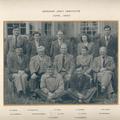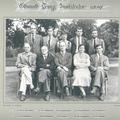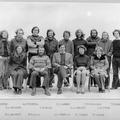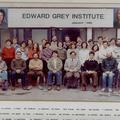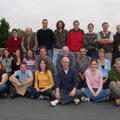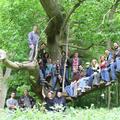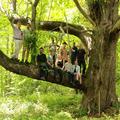Home
WELCOME
to the Edward Grey Institute of Field Ornithology
The Edward Grey Institute of Field Ornithology (EGI) is an internationally renowned centre for scientific research on avian biology, and forms part of the University of Oxford Department of Biology. The institute takes a multidisciplinary approach to address questions related to the behaviour, ecology, evolution, genetics, physiology and conservation of birds.
The birthplace of Behavioural Ecology
The Edward Grey Institute is often considered the birthplace of behavioural ecology, a field that explores how animal behaviour evolves in response to ecological and evolutionary pressures. During the 1960s and 70s, research at the institute moved beyond simple descriptions of behaviours to asking deeper questions about why animals behave the way they do from an adaptive point of view. Leading figures like John Krebs and Nick Davies were instrumental in this shift, combining detailed field observations with evolutionary theory and quantitative models. This new framework was formalised in their influential textbook Behavioural Ecology: An Evolutionary Approach, first published in 1978, which helped define the field and establish behavioural ecology as a major discipline in modern biology. Their later book, An Introduction to Behavioural Ecology, has become essential reading for generations of students and researchers alike.
The Alexander Library
The institute's Alexander Library of Ornithology (now based in the Radcliffe Science Library) is one of the most important ornithological reference libraries in the world, containing extensive collections of 19th, 20th and 21st century books, pamphlets and periodicals, and an archive of ornithological notebooks and diaries. It is an international resource with the collections covering ornithology, natural history, conservation, ecology and behaviour.
Founded in the 1930's on the personal collections of Wilfrid Backhouse Alexander, the Alexander Library was originally housed at 91 Banbury Road and later moved into the Zoology Department in the Tinbergen Building. W.B. Alexander was the first Director of the Oxford Bird Census (the predecessor of the EGI) and on his retirement in 1945 he became the first Librarian, holding the position until 1955. The Library was named in his honour in 1947. The Library moved into the Radcliffe Science Library in 2017 and is now stored offsite.
Today, much of the material within the collections is received via donation or through exchange schemes. The library enjoys a close relationship with the British Ornithologists' Union and books which have been reviewed within its journal, The Ibis, are subsequently deposited in the Alexander Library.
More information of how to access the library's collections can be found here: libguides.bodleian.ox.ac.uk/ornithology

Credit: Bodleian Libraries
The Wytham Tit Project
The Edward Grey Institute runs the Wytham Tit Project; a long-term population study of two woodland bird species - great tits (Parus major) and blue tits (Cyanistes caeruleus) - based at Wytham Woods near Oxford. The project was established in 1947 by John Gibb and David Lack, inspired by pioneering work by Kluijver in the Netherlands, in order to study the breeding biology of the great tit. Lack initially put up 100 nest boxes in Marley Wood, one section of Wytham Woods; the study was later expanded around 1960 to cover the entire 385-hectare woodland using over 1000 fixed location nest boxes. Over the ensuing decades, we have monitored all the breeding attempts in these boxes and individually-marked all parents and offspring (spanning over 40 generations), making this one of the longest running ecological studies of marked wild individual animals in the world.
Wytham Woods was bequeathed to the University by the ffennell family in 1942 after the death of their only child, Hazel. The ffennels requested that the woods be used "for the instruction of suitable students" and to "provide facilities for research". Accordingly, the woods became the University's ecological laboratory (a.k.a. The Laboratory with Leaves), with scientists using the woods to research climate change and the behaviour and ecology of birds, bats, badgers and rodents.
https://www.youtube.com/embed/PIKpAbprhi8?si=grlhmhQ0FFIOCh8U
The Abbotsbury Swannery
The Edward Grey Institute has a long-standing connection with Abbotsbury Swannery in Dorset, home to the world’s only managed colony of nesting mute swans, providing an unparalleled opportunity to study swan behaviour and ecology in a semi-natural yet accessible setting. Long-term monitoring of the swan population at Abbotsbury began in 1968, headed by Chris Perrins, who was appointed Warden of the Swans in 1993. Research using this dataset has yielded valuable insights into topics such as mating systems, territoriality, and parental care. During the summer moult when swans are flightless, the swannery team and volunteers from across the country gather and ring every swan in the Fleet at biennial round-up events, allowing research into individual-level and intergenerational questions. A similar event takes place every year on the River Thames, called the Swan Upping, to conduct an annual census and ringing of the swan population. The collaboration between the EGI and the Swannery stands as a testament to the value of long-term ecological study systems in behavioural research.
A timeline of the Institute's key dates
| 1927 | Founding of the Oxford Bird Census, which later evolved into the EGI |
| 1938 | The EGI is founded by Max Nicholson, Bernard Tucker, and Wilfrid Backhouse Alexander, named in honour of Viscount Grey of Falloden |
| W.B. Alexander becomes the EGI's first Director | |
| 1945 | David Lack becomes Director of the EGI |
| W.B. Alexander retires as Director and becomes Librarian of the institute's Alexander Library of Ornithology, later named in his honour. | |
| 1947 | John Gibb starts the Wytham Tit Study on the biology of great tits, with 200 nest boxes erected in Marley Wood, Wytham Estate. |
| 1960 | The Wytham Tit Study is expanded to 1209 nest boxes across Wytham Woods for the standardised monitoring of great and blue tits. |
| 1974 | Chris Perrins becomes Director of the EGI |
| 2004 |
Ben Sheldon becomes Director of the EGI and first holder of Luc Hoffman Chair in Field Ornithology |
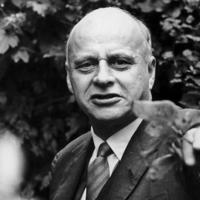
Max Nicholson

Bernard Tucker
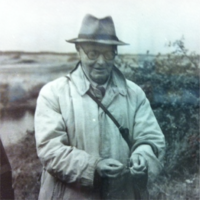
W. B. Alexander

David Lack

Chris Perrins
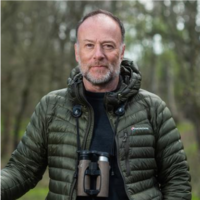
Ben Sheldon
The Institute has been home to many over the past 87 years.
Through these years, we have celebrated some momentous occasions
Research focus at the EGI has evolved over the past decades. Below we showcase some key papers representative of their era's research aims.
1. Population fluctuations and clutch-size in the Great Tit, Parus major L., The Journal of Animal Ecology
Prof Chris Perrins' thesis work established much of our key understanding about the population biology of great tits including the links between timing of breeding, temperature, and the importance of beech mast for the survival of juveniles.

2. Territory and Breeding Density in the Great Tit, Parus Major L., Ecology
Another of the classic Wytham Tit studies is by Prof Lord John Krebs, who carried out seminal work in the late 1960s testing the role of territorial behaviour in regulating populations, showing how territorial birds in prime habitats displace other birds to poorer sites; when prime space is vacated, it is quickly reoccupied.
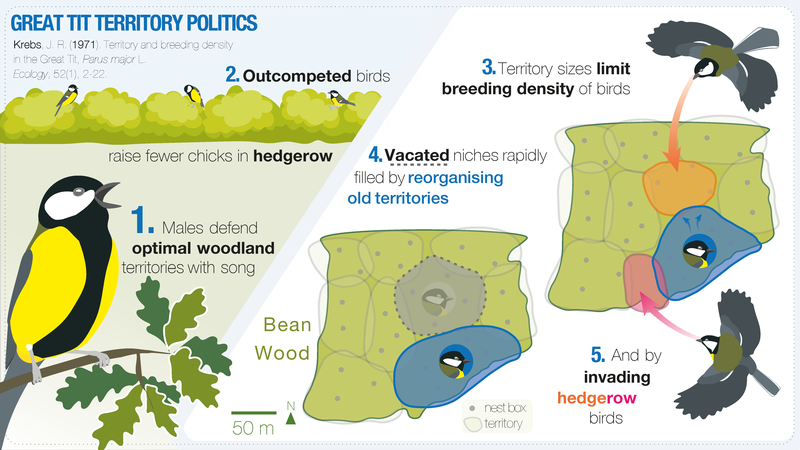
3. Adaptive Phenotypic Plasticity in Response to Climate Change in a Wild Bird Population, Science
doi.org/10.1126/science.1157174
By the late 1990s it was clear that climate change was beginning to influence the tits' behaviour. Dr Anne Charmantier and Prof Ben Sheldon led work showing that the population's tracking of their caterpillar food supply was accomplished by phenotypic plasticity.
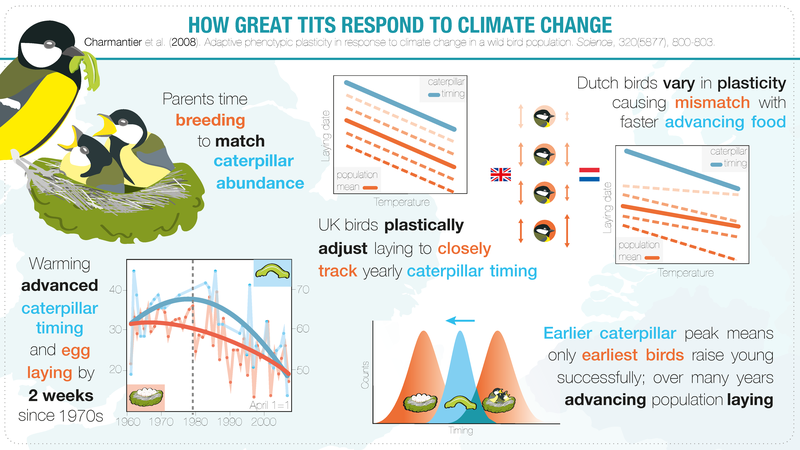
4. Experimentally induced innovations lead to persistent culture via conformity in wild birds, Nature
Prof Lucy Aplin led work together with Prof Damien Farine, Prof Ben Sheldon and others which showed how behavioural innovations could transmit rapidly through social networks and lead to the establishment of stable cultural differences - remaining stable even across generations.














